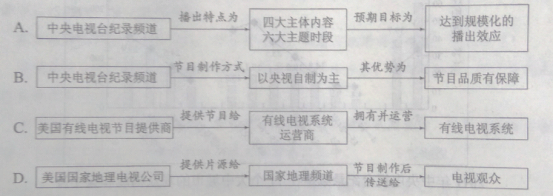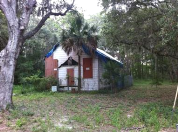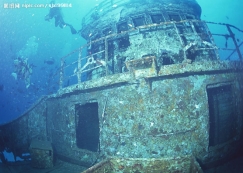ĚâÄżÄÚČÝ
ˇľĚâÄżˇż˛ÄÁĎŇ»Łş
2011Äę1ÔÂ1ČŐ8µăŐűŁ¬ÖĐŃëµçĘǪ́ĽÇ¼ƵµŔŐýĘ˝żŞ˛ĄŁ¬ĐźŸ˛¸ÇČ«ÇňŁ¬×÷ÎŞÖĐąúµÚŇ»¸öąúĽŇĽ¶µÄרҵĽÍ¼ƬƵµŔŁ¬Ň˛ĘǵÚŇ»¸ö´ÓżŞ˛ĄÖ®ĘĽľÍĂćĎňČ«Çň˛ÉÓĂË«ÓﲥłöµÄƵµŔŁ¬ËüĎňĘŔČËÁÁłöÁËÓµÓĐČËÎÄľ«ÉńµÄÖĐąúĐÎĎóˇŁŃëĘÓĽÍ¼ƵµŔÔÚÄÚČݱŕĹĹÉĎ˝řĐĐÁËĎęϸµÄąć»®Ł¬Ö÷ŇŞłĘĎÖËÄ´óÖ÷ĚĺÄÚČݡ˘Áů´óÖ÷Ěâʱ¶ÎµÄ˛ĄłöĚص㣬ŇÔĆÚ´ďµ˝ąćÄŁ»ŻµÄ˛ĄłöЧӦˇŁŃëĘÓĽÍ¼ƵµŔͬʱ˛ÉÓĂąúĽĘĽÍ¼ƬƵµŔµÄͨĐĐ·˝Ę˝Ł¬µ»ŻŔ¸Äż¸ĹÄǿ»Ż´óʱ¶Î±ŕĹĹŁ¬ŇÔÖ÷Ě⻯ˇ˘ĎµÁĐ»ŻşÍ˛ĄłöĽľµÄ·˝Ę˝Ł¬ĚáÉý×ÔÉíµÄÓ°ĎěÁ¦şÍĂŔÓţ¶ČˇŁ
Ł¨Őޱŕ×ÔŃîÓń˝ŕµČˇ¶ŐćʵľŰ˝ąŁş2010~2011ÖĐąúĽÍ¼ƬƵµŔÔËÓŞÓëĽÍ¼Ƭ˛úҵ·˘ŐąĽÇÂĽˇ·Ł©
˛ÄÁ϶ţŁş

עŁşČşÖÚąąłÉ·´ÓłµÄĘÇĘŐĘÓČËČşµÄąąłÉŁ¬»Ř´đÁˡ°ËÔÚż´¸ĂƵµŔˇ±µÄÎĘĚ⣬ĽŻÖжČĘÇÄż±ęČşÖÚĘŐĘÓÂĘÓë×ÜĚĺČşÖÚĘŐĘÓÂʵıČÖµŁ¬±íĘľµÄĘÇÄż±ęČşÖÚĎŕ¶ÔÓÚ×ÜĚĺąŰÖÚµÄĘŐĘÓĽŻÖг̶ȣ¬ÄÜą»»Ř´đˇ°Ë¸üϲ»¶ĘŐż´Őâ¸öƵµŔˇ±µÄÎĘĚ⣻ĽŻÖжȵıČÖµ´óÓÚ100%Ł¬±íĘľ¸ĂŔŕÄż±ęČşÖÚµÄĘŐĘÓÇăĎň¸ßÓÚĆ˝ľůˮƽˇŁ
˛ÄÁĎČýŁş
ÔÚÖƲĄÔËÓŞÄŁĘ˝·˝Ă棬ŃëĘÓĽÍ¼ƵµŔʵĐеÄĘÇƵµŔ»ŻÔËÓŞÄŁĘ˝ˇŁŃëĘÓĘÇĽÍ¼ƬµÄÖ÷ŇŞÖĆ×÷»ůµŘˇŁÖĆ×÷łöµÄľ«Ć·˝ÚÄżĘýÁżÖڶࡣµ±Č»Ł¬ĆµµŔ»ŻÔËӪģʽҲÓĐĆä×ÔÉíµÄÁÓĘĆŁ¬ÁÓĘĆÔÚÓÚƵµŔżÉŇÔµ÷¶ŻµÄ×ĘÔ´·ÇłŁÓĐĎŢŁ¬ĆäČÚ×ĘÇţµŔˇ˘˛úĆ·ÉčĽĆˇ˘Č˲ĆÎď×ĘÔ´µ÷¶Č¶Ľ»áĘܵ˝ÖÖÖÖĎŢÖơŁŃëĘÓĽÍ¼ƵµŔĿǰŐý»ýĽ«ÍĆ˝řÖƲĄ·ÖŔëÄŁĘ˝Ł¬˝ÚÄżÖĆ×÷ŇÔÉç»áŐбꡢÁŞşĎÖĆ×÷ˇ˘ąşÂň×÷ÎŞÖ÷ŇŞ·˝Ę˝Ł¬˛˘¸¨ŇÔ×ÔÖĆľ«Ć·Ł¬ÎŞ˝¨Á˘˝ĎÎŞ˝ˇČ«µÄÖĆ×÷ąÜŔíÄŁĘ˝×öşĂ׼±¸ˇŁ
Ł¨Őޱŕ×ÔŐĹͬµŔµČˇ¶2011ÄęąúĽŇĽÍ¼ƬƵµŔ·˘Őą±¨¸ćŁ¨ĎÂŁ©ˇ·Ł©
˛ÄÁĎËÄŁş
×ܲżÎ»ÓÚĂŔąúĘ׶Ľ»ŞĘ˘¶ŮµÄąúĽŇµŘŔíƵµŔĘÇŇ»¸öČ«ÇňĐԵĸ¶·ŃÓĐĎßµçĘÓÍřˇŁÄżÇ°Ł¬ąúĽŇµŘŔíƵµŔŇŃľŇÔ34ÖÖÓďŃÔת˛ĄÖÁČ«Çň166¸öąúĽŇşÍµŘÇřÓâ2ŇÚ9ǧÍňÓĂ»§Ł¬×÷ÎŞŇ»¸ö´żĽÍ¼ƬƵµŔÄÜą»ČˇµĂČç´Ë׿ԽµÄłÉľÍŁ¬łýÁ˸ßÖĘÁżˇ˘¸ßąŰÉÍĐԵĽÚÄżÄÚČÝÖ®Í⣬ÓëĆäƵµŔ×ÔÉíµÄÖƲĄÔËÓĂÄŁĘ˝ĘÇ·Ö˛»żŞµÄˇŁĆäÖƲĄÔËÓŞÄŁĘ˝ČçĎÂŁşÓĐĎßµçĘÓϵͳĘÇÔڵط˝Őţ¸®µÄĹú׼ĎÂÓÉÓĐĎßµçĘÓϵͳÔËÓŞÉĚͶ×Ę˝¨Á˘µÄŁ¬ÓĐĎßµçĘÓϵͳֱ˝ÓĂćĎň¶©»§ĘŐȡ·ŃÓĂŁ¬ÓĐĎßµçĘÓϵͳÔËÓŞÉĚĘÇÖ¸ÓµÓв˘ÔËÓŞÓĐĎßµçĘÓϵͳµÄĆóҵʵĚ塣ÓĐĎßµçĘÓ˝ÚÄżĚáą©ÉĚÎŞÓĐĎßµçĘÓϵͳÔËÓŞÉĚĚáą©˝ÚÄżŁ¬ľßĚĺµ˝ąúĽŇµŘŔíƵµŔ¶řŃÔŁ¬ĂŔąúąúĽŇµŘŔíµçĘÓą«ËľŇÔĽ°ĆäËűÇţµŔłĐµŁĚṩƬԴµÄČÎÎńŁ¬ąúĽŇµŘŔíƵµŔłĐµŁµÄĘÇ˝ÚÄżÖĆ×÷µČČÎÎńŁ¬Ľ´ČĂŔ´×ÔąúĽŇµŘŔíµçĘÓą«ËľµČÇţµŔµÄµĄ¸öµÄƬԴ±äłÉÓĐ»ú˝áşĎµÄŐűĚ壬ĘĘÓÚÔÚµçĘÓÉϲĄ·ĹŁ»żµż¨ËąĚصçĐĹą«Ëľ×÷ÎŞÓĐĎßµçĘÓϵͳÔËÓŞÉĚŁ¬ÔňłĐµŁ°ŃµçĘÓĐźŴ«Ë͵˝Ç§ĽŇÍň»§µÄµçĘÓ»úÉϵļĽĘőĐÔ˛ĄłöČÎÎńˇŁ Ł¨Őޱŕ×Ôłţ»ŰĆĽˇ¶¶ŕÔŞŃÓÉ죬ÓĐ»ú»Ą¶ŻˇŞˇŞĂŔąúąúĽŇµŘŔíƵµŔÔËÓŞÄŁĘ˝łőĚ˝ˇ·Ł©
ˇľ1ˇżĎÂÁжԲÄÁĎĎŕąŘÄÚČݵÄĘáŔíŁ¬˛»ŐýČ·µÄŇ»ĎîĘÇŁ¨3·ÖŁ©
ˇľ2ˇżĎÂÁжԲÄÁĎĎŕąŘÄÚČݵĸĹŔ¨şÍ·ÖÎöŁ¬ŐýČ·µÄÁ˝ĎîĘÇ
AŁ®ÖĐŃëµçĘǪ́ĽÇ¼ƵµŔÔÚÄÚČݱŕĽÉĎ˝řĐĐÁËČĎŐćĎęϸµÄąć»®Ł¬ŇÔĆÚ˝«Ŕ´ÄÜą»łĘĎÖłöÖ÷Ě⻯ˇ˘ĎµÁĐ»ŻµÄ˝ÚÄż˛Ąłö·˝Ę˝ˇŁ
BŁ®¸ůľÝ˛ÄÁ϶ţÖĐĐÔ±đˇ˘ÄęÁ䡢ѧŔúŐâČýĎÎŇĂÇÄÜą»Á˽⵽ÖĐŃëµçĘǪ́ĽÍ¼ƵµŔµÄąŰÖÚąąłÉşÍĽŻÖжȵĻů±ľÇéżöˇŁ
CŁ®2011Ä꣬ÔÚ71¸ö´óÖĐłÇĘеĹŰÖÚµ÷˛éÖĐŁ¬ÖĐŃëµçĘÓµç̨ĽÍ¼ƵµŔąŰÖÚąąłÉ×î¸ßµÄČýŔŕČËČş·Ö±đĘÇŁşÄĐĐÔˇ˘45~54ËęŇÔĽ°¸ßÖĐѧŔúˇŁ
DŁ®¸ůľÝ˛ÄÁ϶ţżÉÖŞŁ¬Ëć×ĹÄż±ęąŰÖÚÄęÁäµÄÔöĽÓŇÔĽ°Ń§ŔúµÄÔö¸ßŁ¬ĽŻÖжȵıČֵҲÔÚ˛»¶ĎµŘĹĘÉýˇŁ
EŁ®ĂŔąúąúĽŇµŘŔíƵµŔµÄÖĆ×÷ąÜŔíÄŁĘ˝˝ĎÎŞ˝ˇČ«Ł¬ËüÔÚČÚ×ĘÇţµŔˇ˘˛úĆ·ÉčĽĆˇ˘Č˲ĆÎď×ĘÔ´µ÷¶Č·˝Ă治´ćÔÚĘܵ˝ĎŢÖƵÄÎĘĚ⡣
ˇľ3ˇż¸ůľÝÉĎĘö˛ÄÁĎŁ¬¸ĹŔ¨ËµĂ÷ÖĐŃëµçĘǪ́ĽÍ¼ƵµŔżŞ˛ĄłőĆÚÓëĂŔąúąúĽŇµŘŔíƵµŔÔÚÖ±˛ĄÔËÓŞÄŁĘ˝·˝ĂćµÄ˛»Í¬ˇŁ
ˇľ´đ°¸ˇż
ˇľ1ˇżD
ˇľ2ˇżBC
ˇľ3ˇż˘ŮÖĐŃëµçĘǪ́ĽÇ¼ƵµŔÔÚżŞ˛ĄłőĆÚ˛ÉÓõÄĘÇƵµŔ»ŻÔËÓŞÄŁĘ˝Ł¬ŃëĘÓĘÇĽÍ¼ƬµÄÖ÷ŇŞÖĆ×÷»ůµŘŁ»˘ÚĂŔąúąúĽŇµŘŔíƵµŔ˛ÉÓõÄĘÇÖƲĄ·ÖŔëµÄÔËÓŞÄŁĘ˝Ł¬˝ÚÄżµÄÖĆ×÷Ó벥łöĎŕ¶Ô·ÖŔ롣
ˇľ˝âÎöˇż
ˇľ1ˇż±ľĚâ×ۺϿĽ˛éÎÄŐµÄÄÚČÝşÍĘÖ·¨ˇŁżĽÉúÓ¦Öصă·ÖÎöѡĎîÄÚČÝÓëÎÄŐÂÄÚČݵÄÎǺ϶ȡŁÔÎÄÓС°ŇÔĽ°ĆäËűÇţµŔˇ±ˇŁ±ľĚâ´ÓżĽ˛éµÄ·¶Î§Ŕ´ż´Ł¬ĽČÉ漰ȫƪŁ¬ÓÖ˛ŕÖŘľÖ˛żŁ»´ÓżĽ˛éµÄ˝Ç¶ČŔ´ż´Ł¬ĽČÓĐÖ÷ÖĽ´íÎóŁ¬Ň˛ÓĐϸ˝Ú´íÎ󡣽â´đ´ËŔŕĚâµÄ·˝·¨ŁşÍ¨¶ÁČ«ÎÄŁ¬ąŘעϸ˝ÚˇŁ
ˇľ2ˇż±ľĚâ×ۺϿĽ˛éɸѡ˛˘ŐűşĎÎÄÖеÄĐĹϢˇŁAĎîÄżµÄ´íÎóŁ¬ÔÎÄÎŞˇ°ŃëĘÓĽÍ¼ƵµŔÔÚÄÚČݱŕĹĹÉĎ˝řĐĐÁËĎęϸµÄąć»®ˇˇŇÔĆÚ´ďµ˝ąćÄŁ»ŻµÄ˛ĄłöЧӦˇŁŃëĘÓĽÍ¼ƵµŔͬʱˇˇŇÔÖ÷Ě⻯ˇ˘ĎµÁĐ»ŻşÍ˛ĄłöĽľµÄ·˝Ę˝Ł¬ĚáÉý×ÔÉíµÄÓ°ĎěÁ¦şÍĂŔÓţ¶Čˇ±ˇŁDĎîąéŔŕ´íÎóŁ¬ÓÉÍĽ±íżÉÖŞŁ¬55ËęŇÔÉĎČËČşĽ°ˇ°´óѧĽ°ŇÔÉϡ±Ń§ŔúąŘע¶ČĎ½µˇŁEĎîżĎ·ń˛»µ±Ł¬ÔÎÄĘÇ˵ĐčŇŞˇ°µŘ·˝Őţ¸®µÄĹú׼ˇ±Ł¬żÉĽűҲĘÇÓĐĎŢÖƵġŁÍ¨¶ÁČ«ÎÄŁ¬ąŘעϸ˝ÚˇŁµÚŇ»˛˝ŁşÍ¨¶ÁČ«ÎÄŁ¬ŐűĚĺ¸ĐÖŞˇŁ°ŃÎŐÎıľ»ů±ľĘÂʵŁ¬·ÖÎöÖ÷Ěĺ¶ÔĎóÓë»ů±ľĘÂʵ֮ĽäµÄąŘϵˇŁµÚ¶ţ˛˝ŁşĂ÷Č·Ö÷ÖĽŁ¬±ćÇĺąŘϵˇŁ˝áşĎѡĎîÖ®ĽäµÄąŘϵ×öłö׼ȷĹжϡŁ
ˇľ3ˇżŐâĘÇŇ»µŔɸѡĐĹϢˇ˘ŐűşĎĐĹϢµÄĚ⣬ҪĎë´đ¶ÔŁ¬Ę×ĎČŇŞ¸ůľÝĚâ¸ÉŇŞÇ󣬱ŘĐë°Ń´đĚâÇřĽäŐҶԣ¬´ÓÖĐɸѡłö¶Ô´đ°¸ÓĐ°ďÖúµÄĐĹϢŁ¬Č»şó»ąŇŞ»á¸ĹŔ¨Ł¬Ň޵ăŇŞĽň˝ŕŁ¬ľˇÁżĘąÓĂÎÄÖĐ´ĘÓÓɡ°˛ÄÁĎČýˇ±żÉÖŞŁ¬ˇ°ÔÚÖƲĄÔËÓŞÄŁĘ˝·˝Ă棬ŃëĘÓĽÍ¼ƵµŔʵĐеÄĘÇƵµŔ»ŻÔËÓŞÄŁĘ˝ˇŁˇˇÄżÇ°Őý»ýĽ«ÍĆ˝řÖƲĄ·ÖŔëÄŁĘ˝ˇ±Ł¬Óɡ°˛ÄÁĎËġ±żÉÖŞˇ°ĆäÖƲĄÔËÓŞÄŁĘ˝ČçĎÂŁşÓĐĎßµçĘÓϵͳĘÇÔڵط˝Őţ¸®µÄĹú׼ĎÂÓÉÓĐĎßµçĘÓϵͳÔËÓŞÉĚͶ×Ę˝¨Á˘µÄŁ¬ÓĐĎßµçĘÓϵͳֱ˝ÓĂćĎň¶©»§ĘŐȡ·ŃÓᱡŁĎČ·ş¶ÁŁşÁË˝âÎÄŐ´óŇ⡢˝áąąŁ¬Č¦łöąŘĽü´Ęˇ˘ľäŁ»ÔŮÉóĚ⣺ȷ¶¨·¶Î§ˇ˘˝Ç¶Čˇ˘ŇŞÇóŁ»Č»şóľ«¶ÁŁşŃ°ŐŇĎŕąŘĐĹϢŁ¬É¸ŃˇąŘĽü´ĘÓ×îşóĽÓą¤Łş°´ĚâĿҪÇóŐűşĎĐĹϢˇŁ

 ÔĶÁżěłµĎµÁĐ´đ°¸
ÔĶÁżěłµĎµÁĐ´đ°¸



